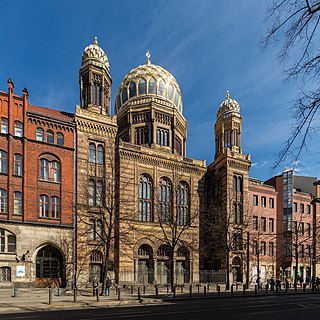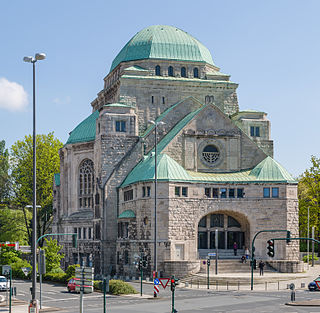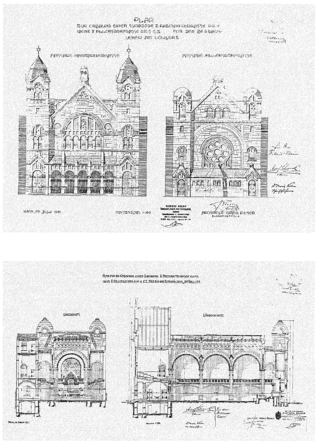
Hietzing is the 13th municipal District of Vienna. It is located west of the central districts, west of Meidling. Hietzing is a heavily populated urban area with many residential buildings, but also contains large areas of the Vienna Woods, along with Schönbrunn Palace.

The New Synagogue on Oranienburger Straße in Berlin is a mid-19th century synagogue built as the main place of worship for the city's Jewish community, succeeding the Old Synagogue which the community outgrew. Because of its eastern Moorish style and resemblance to the Alhambra, the New Synagogue is an important architectural monument in Germany.

The Leopoldstädter Tempel, also known as the Israelitische Bethaus in der Wiener Vorstadt Leopoldstadt, was a Jewish congregation and synagogue, located on Tempelgasse 5, in Leopoldstadt, in the 2nd district of Vienna, Austria. Completed in 1858, the synagogue was destroyed as a result of Kristallnacht. A monument marks the location of the former synagogue.

The Stadttempel, also called the Seitenstettengasse Temple, is an Orthodox Jewish synagogue, located at Seitenstettengasse 4, in the Innere Stadt 1st district of Vienna, Austria. Completed in 1826, it is the main synagogue in Vienna. The congregation worships in the Ashkenazi rite.

The Old Synagogue in Essen is one of the largest, best preserved and architecturally most impressive testimonies to Jewish culture in pre-war Germany. Built in the centre of the city, the Byzantine style former Synagogue was originally consecrated as the Neue Synagoge in 1913; it now houses an institution dedicated to documenting and promoting the history of the city's former Jewish community.

Neudeggergasse Synagogue was a Jewish synagogue, located at Neudeggergasse 10–12, Josefstadt, in the 8th district of Vienna, Austria. The synagogue served the Jewish community of Neubau and Josefstadt, the 7th and 8th districts of Vienna.

The Türkischer Tempel was a Jewish synagogue, located at Zirkusgasse 22, in Vienna, Austria. It was built specifically for a community of Sephardi Jews, who originally came from Turkey.

The Polnische Schul was an Orthodox Jewish synagogue, located in Leopoldsgasse, Vienna, Austria.

Moorish Revival or Neo-Moorish is one of the exotic revival architectural styles that were adopted by architects of Europe and the Americas in the wake of Romanticist Orientalism. It reached the height of its popularity after the mid-19th century, part of a widening vocabulary of articulated decorative ornament drawn from historical sources beyond familiar classical and Gothic modes. Neo-Moorish architecture drew on elements from classic Moorish architecture and, as a result, from the wider Islamic architecture.

The Pazmanitentempel, also known as the Jubiläumstempel, was a Jewish synagogue, located at Pazmanitengasse 6, Leopoldstadt, in the 2nd district of Vienna, Austria. Completed in 1913, the synagogue was destroyed on Kristallnacht in 1938.

The Vienna General Hospital, usually abbreviated to AKH, is the general hospital of the city of Vienna, Austria. It is also the city's university hospital, and the site of the Medical University of Vienna. It is Europe's fifth largest hospital, both by number of employees and bed capacity.

Rykestrasse Synagogue, Germany's largest synagogue, is located in the Prenzlauer Berg neighbourhood in the Pankow borough of Berlin. Johann Hoeniger built the synagogue in 1903/1904. It was inaugurated on 4 September 1904, in time for the holidays of and around Rosh Hashanah. The synagogue stands off the street alignment and is reached by a thoroughfare in the pertaining front building.

Congregation Beth Israel is a Reform Jewish congregation and synagogue, located at 1931 NW Flanders Street, Portland, Oregon, in the United States.

The Semper Synagogue, also known as the Dresden Synagogue, designed by Gottfried Semper and built from 1838 to 1840, was dedicated on 8 May 1840. It was an early example of the Moorish Revival style of synagogue architecture.

Schiffschul, officially Khal Adas Yisroel, was a former Orthodox congregation and synagogue, located at Grosse Schiffgasse 8, in the second district, known as Leopoldstadt, Vienna, Austria. The synagogue was destroyed by the Nazis on Kristallnacht in 1938. The congregation worshiped in the Ashkenazi rite.

The Döbling Synagogue was a former Jewish synagogue that was located in the Dollinergasse in the suburb of Oberdöbling, in Döbling, in the 19th district of Vienna, Austria. Completed in 1907, the building was ruined and partially destroyed in the Kristallnacht pogrom of November 1938. Later, the synagogue was deconsecrated and in 1995, it was replaced with a modern apartment tower.

Spandau Synagogue was a synagogue at 12 Lindenufer in the Old Town area of Spandau, Berlin, Germany. It was also known as Spandauer Vereinssynagoge. The synagogue was built in 1894–95 and was destroyed on 9 November 1938 (Kristallnacht) when it was set on fire. The ruins were removed, probably in 1942. The site is now marked by a memorial tablet, installed in 1988. The congregation maintained a Jewish cemetery, on Spandau's Neue Bergstrasse, which was closed by the Nazi government and was evacuated in 1939 to the Cemetery of the Orthodox congregation Adass Jisroel in Berlin.

The synagogue on Fraenkelufer in Berlin's Kreuzberg district was built as an Orthodox Synagogue between 1913 and 1916 according to plans and under the direction of the master builder of the Jewish Community of Berlin, Alexander Beer. The structure was located on Kottbusser Ufer 48–50, today's Fraenkelufer 10-16. On Kristallnacht, the evening of November 9-10th, 1938, the main building of the synagogue was badly damaged. Further destruction in the following years led to the structures ultimate demolition in 1958/1959 after the end of World War II. Today the surviving outbuilding, previously used for the youth service, has been renovated and is home to a Conservative Synagogue. A complete reconstruction of the main synagogue that was destroyed by the Nazis is being planned for its original location.

The Görlitz Synagogue in Görlitz, Germany was built between 1909 and 1911 in the Art Nouveau style and was the main place of worship for the city's Jewish community. Despite an arson attack, the synagogue was one of the few synagogues in the area to survive Kristallnacht, sustaining only minor damage. The damage could have been greater, but was lessened because the firefighters ignored the orders to let the synagogue burn. With the city's Jewish population depleted, the unused synagogue became a ruin in the following decades. In 1991, a restoration project began which was completed in December 2020. Owing to the COVID-19 pandemic, the opening ceremony was postponed until 2021. The synagogue duly opened on July 12, 2021. On September 12, 2022, a new Magen David was placed on top of the synagogue.

The New Synagogue of Graz is a Jewish congregation and synagogue, located on David-Herzog-Place, on the right bank of the Mur River in the Gries neighborhood, in the city of Graz, Austria. The synagogue serves the Jews of Graz, Styria, Carinthia, and southern parts of Burgenland.





















